In 2016, hoarding by the tenants of more than two dozen downtown residential buildings had become so pervasive that employees felt it posed a health and safety hazard.
The Skid Row Housing Trust, a nonprofit that owned the buildings, hired a specialist — clinical psychologist Danielle Schlichter. Her job was to set up a training program for graduate students who would help tenants overcome the obsessions that set them up for eviction.
But soon, the trust began falling behind on its payments to Schlichter and eventually stopped them, according to emails attached in a lawsuit. She was forced to stop working even as the problems at the buildings persisted, the emails said.
Schlichter’s lawsuit was one of many filed by tenants and creditors, alleging uninhabitable living conditions seeking hundreds of thousands of dollars in unpaid bills. They marked the early signs of management and financial disarray, which festered for years before culminating in the meltdown of an institution that had long stood as a model for housing homeless people.
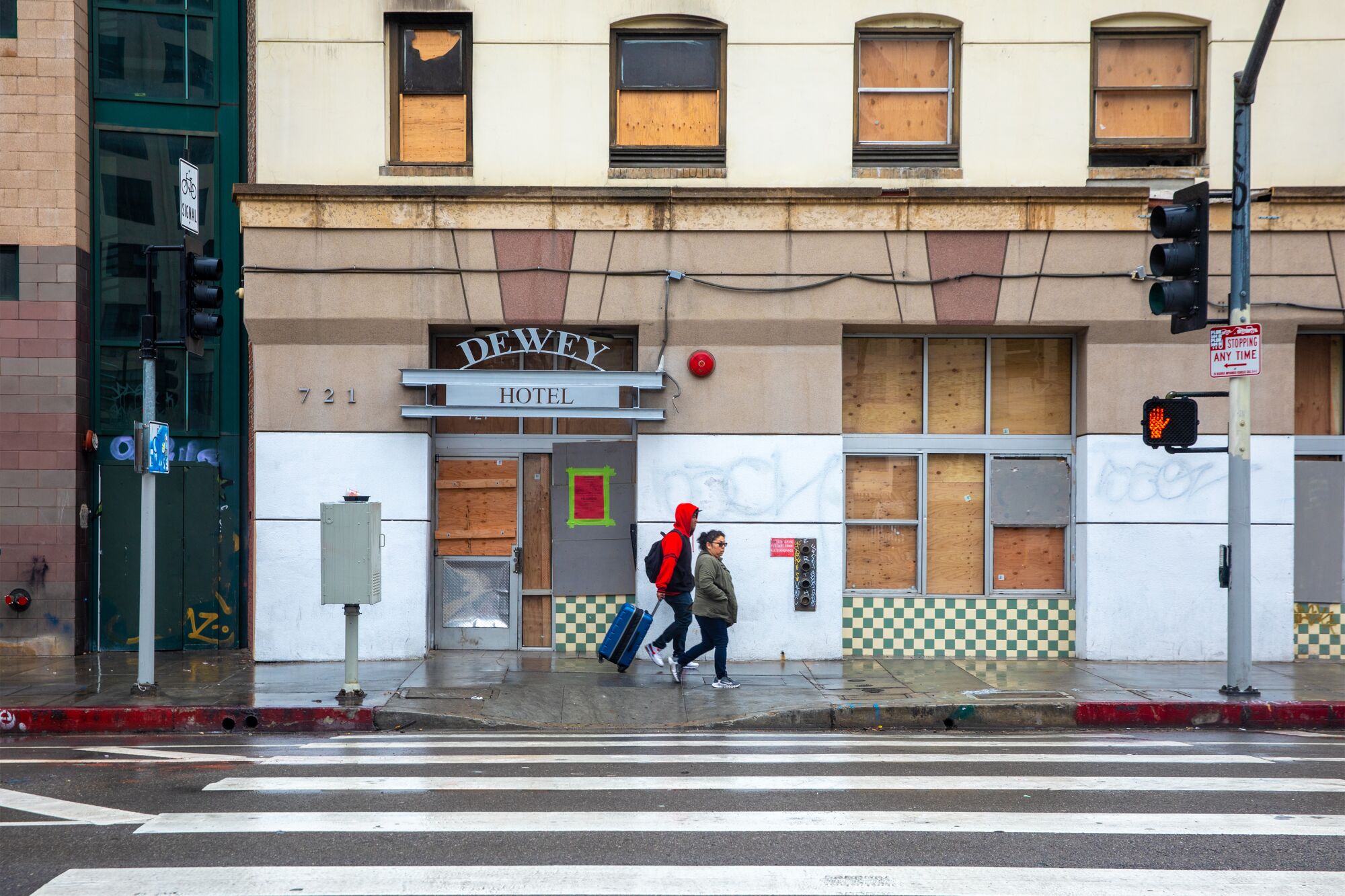
The Skid Row Housing Trust property Dewey Hotel was closed and boarded up after a recent fire.
(Irfan Khan/Los Angeles Times)
Earlier this year, the nonprofit’s interim chief executive acknowledged that the trust could no longer support its 29 residential buildings — many of them operating in the red — and appealed for organizations on firmer financial footing to take them over.
By then, Skid Row Housing Trust had left a trail of disillusioned former employees who found that its business practices did not match its lofty mission of “serving the poorest and most vulnerable people.”
“It was really clear that, whatever sort of battle anyone had imagined that they were waging, what we were currently doing was really bad for the people living in the buildings, and really bad for the people working in the buildings,” said one former staff member who left foreseeing the organization’s coming collapse. “There was just no way to solve the number of problems that we were facing with the amount of time and money we had to solve them.”
A Times examination found that the implosion of the celebrated housing nonprofit was a long time coming. The trust was undone in part by a challenging financing model for the housing stock it set out to save — single room occupancy buildings that it had bought over a period of 30 years to preserve them as low-income housing.
Newsletter
Get the lowdown on L.A. politics
In this pivotal election year, we’ll break down the ballot and tell you why it matters in our L.A. on the Record newsletter.
You may occasionally receive promotional content from the Los Angeles Times.
Through the years, the costs of keeping these buildings habitable only grew as a profoundly vulnerable residential population prone to substance use disorder and other impairments caused damage and chaos. Financial mismanagement and little stable leadership worsened problems.
With so much attention being paid to the city’s unsheltered homeless population, the trust’s downfall has alarmed the leaders of other nonprofit housing developers, exposing the perils of operating aging buildings for formerly homeless people who may experience long-term mental and physical health crises.
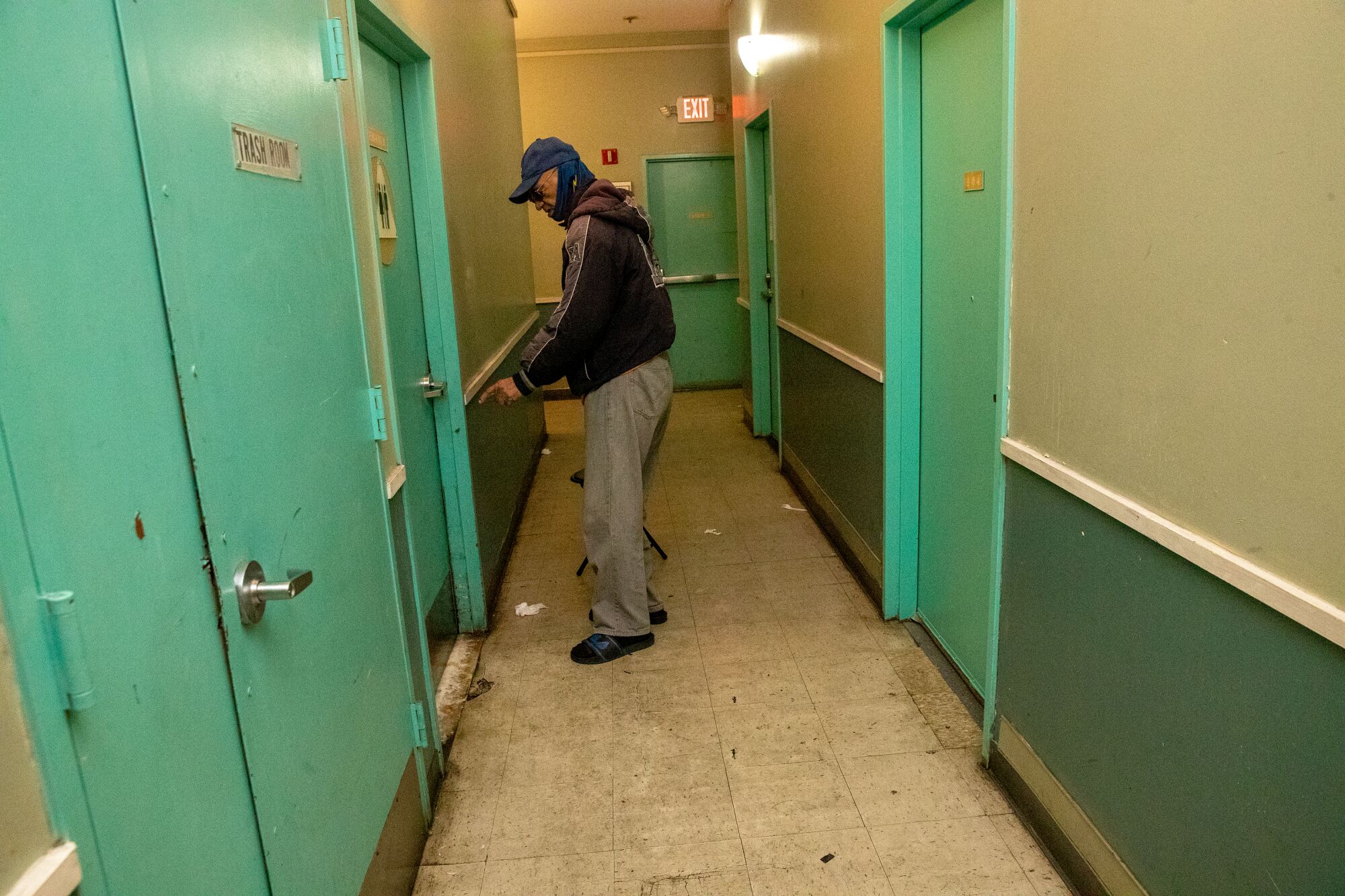
James Porter, 75, complains about filthy floors and unsafe environment at Sanborn Hotel Apartments, where he’s lived 30 years.
(Irfan Khan / Los Angeles Times)
By the time the board of directors decided in October to break up the organization, regulatory setbacks, operating losses and management missteps had gone unaddressed for years. The organization had been cut off from local and state funding, borrowed millions of dollars to make payroll and, in a diversification scheme that horrified old-guard housing advocates, proposed a venture into cannabis production and sales to bring in revenue.
The dysfunction reached an almost comical climax in January when the board, depleted by so many resignations that it might be unable to mount a quorum, recruited a former employee for a single meeting to vote in a bylaw change reducing its size.
“The Trust’s current financial challenges had reached a level that the only path forward is to transition all of the Trust’s interest in the portfolio to other qualified affordable housing providers,” interim CEO Joanne Cordero said in a statement, while not answering a list of detailed questions pertaining to this article.
Even as knowledge of the disintegration permeated the small world of homeless housing providers, leaders of the trust maintained a public front of normalcy, desperately trying to protect the image of a beloved institution and sustain public faith in the permanent supportive housing model it had helped to pioneer.
Those plaudits went further in a 51-minute video timed to the opening of one of its buildings, which included testimonials from elected officials including Rep. Jimmy Gomez (D-Los Angeles), former Mayor Eric Garcetti and Supervisor Holly Mitchell touting the great work of the nonprofit.
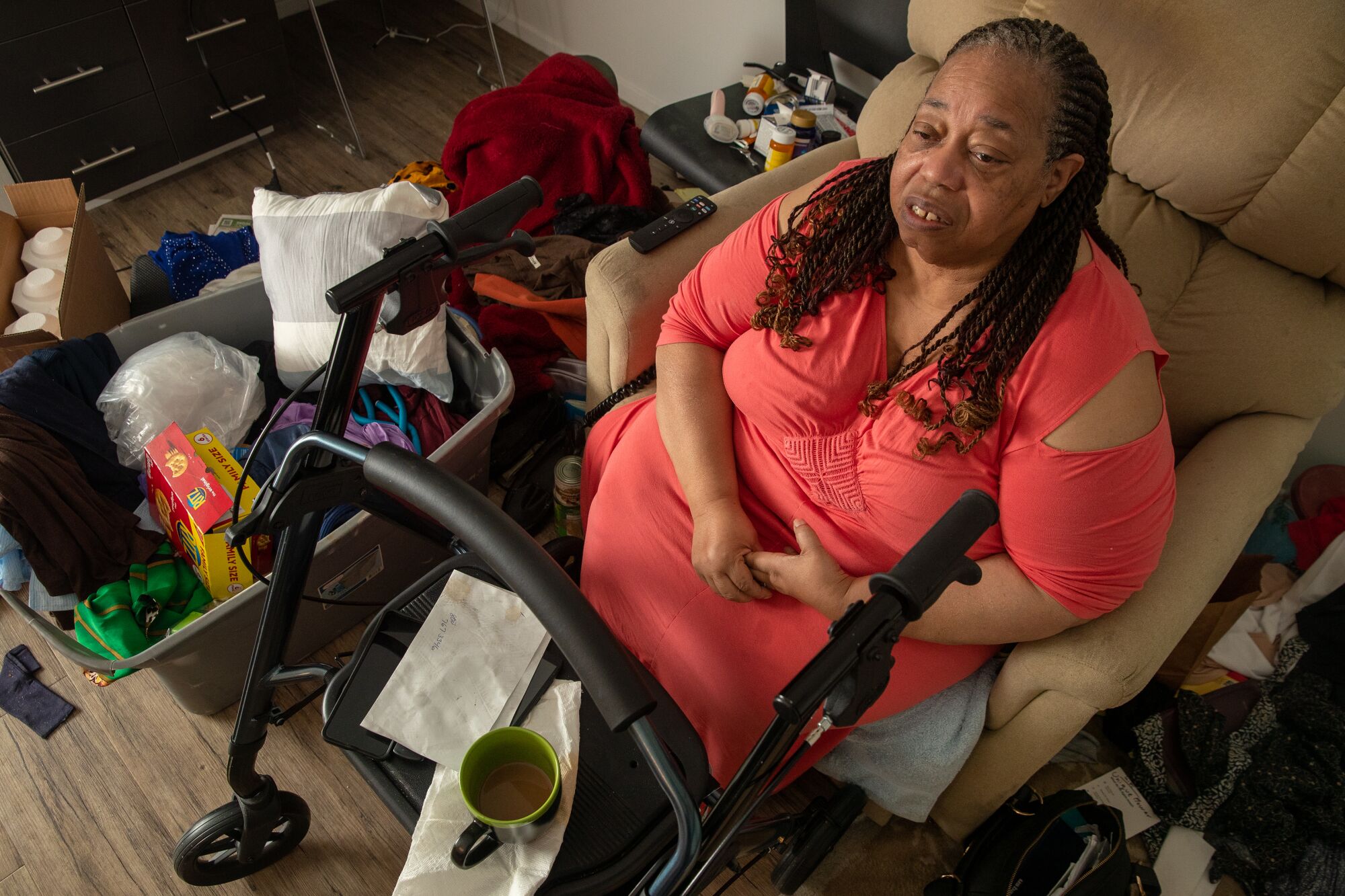
Yolanda Cunningham Smith, 67, stays in her fifth-floor room because the elevators are not working at 649 Lofts in Los Angeles.
(Irfan Khan / Los Angeles Times)
“649 Lofts and the Joshua House Health Center are bringing housing, health and hope to Los Angeles and Angelenos for generations to come,” Garcetti said about the trust’s most recent development, which opened in 2021.
One nonprofit developer described the trust’s troubles as one of the industry’s “worst-kept secrets,” and several others said Skid Row Housing’s collapse has touched off soul-searching within other housing nonprofits whose boards and executives see warning signs of systemic troubles that could threaten their portfolios.
The situation “was both a wake-up call and a cautionary tale to housers everywhere,” said Rochelle Mills, chief executive of Innovative Housing Opportunities, a nonprofit developer in Southern California.
The risk they share is that buildings created with tax credit financing lose their primary investors after they recoup their funds in about 15 years, and their fixed revenue from subsidized rents may not cover long-term maintenance costs such as roof repairs and air conditioner replacements. Private homeowner associations often impose special assessments to fill that gap. Nonprofit housing developers have no one to assess.
Added to that structural challenge is a policy shift of the past decade giving priority for housing to people who have been homeless the longest, have mental and physical health conditions and often substance use disorder. Wear and tear on apartments suffers accordingly, building operators say, potentially creating a downward spiral in which damaged units cannot be reoccupied, cutting into the building’s rental revenue.
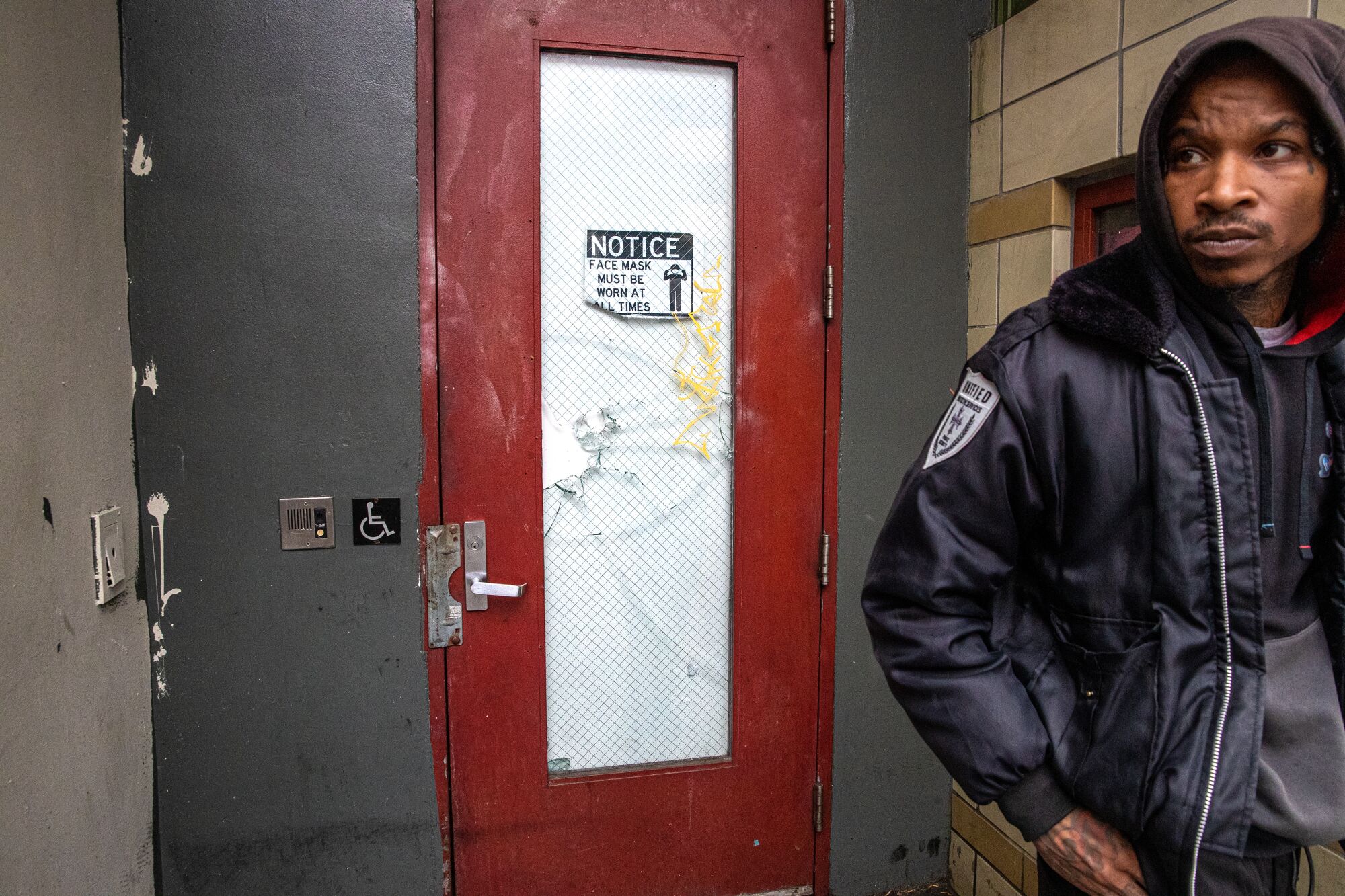
Broken glass panel of main entrance of Sanborn Hotel Apartments in Los Angeles.
(Irfan Khan/Los Angeles Times)
“A few of us have been fighting for years for preservation dollars to be available through the city and the state and the tax credit program,” said Dora Gallo, chief executive of A Community of Friends, a nonprofit that builds and operates subsidized housing.
“The focus at all levels of government is new production, more housing, and there doesn’t seem to be a willingness to invest in older buildings.”
The conundrum was more extreme for Skid Row Housing Trust than for organizations that primarily build new housing because its portfolio is heavily weighted with early 20th century hotels with tiny living spaces, communal bathrooms and kitchens and, in some cases, poorly functioning elevators or no elevators at all.
For years, as its operating funds dipped further into the red, the trust has allowed more of those units to remain vacant. The Housing Authority of the City of Los Angeles, which must clear all subsidized units for occupancy, has holds on 253 units spread over nearly half the trust’s buildings, prohibiting the occupancy of 15% of the nonprofit’s units.
“So you’re losing money,” a former employee said. “When you go beyond seven days and don’t have anyone in the unit, you can’t get paid.”
Interviews with two dozen housing officials, current and former employees and board members revealed a pattern of inattention to those mounting problems that led to deteriorating conditions in the trust’s buildings.
Most of the former employees interviewed by The Times would speak only anonymously out of concern of damaging relationships and jeopardizing employment opportunities in the small world of nonprofit housing. If they were named, some feared, they would be pulled into the vortex of legal disputes currently surrounding the nonprofit. Others said they were advised by their lawyers not to speak on the record.
One former executive said she was dumbstruck when she inspected the buildings to see how the lack of security allowed “a free-for-all.”
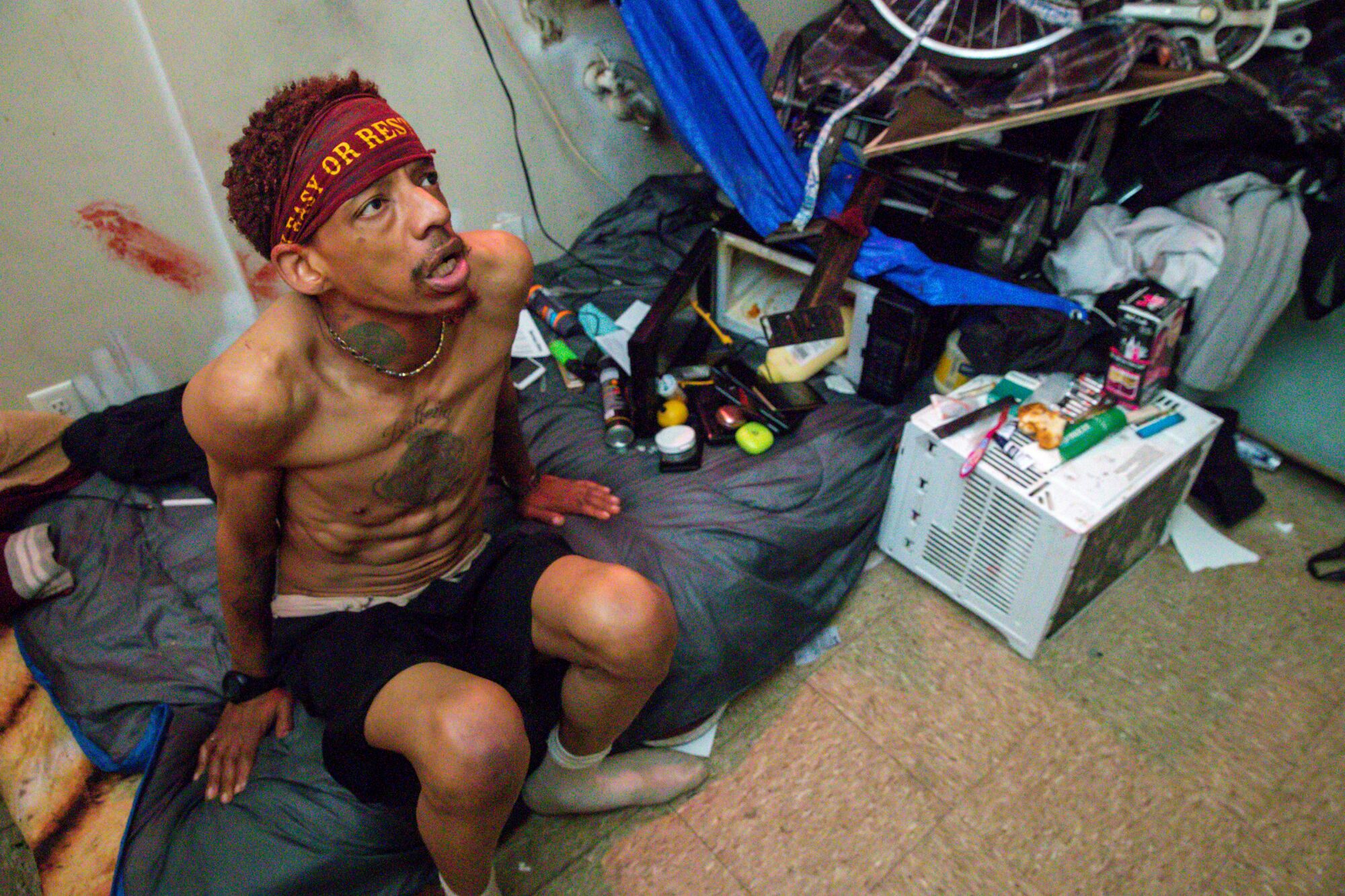
Juan Smith lives in room that has a door that doesn’t close at Sanborn Hotel Apartments in Los Angeles.
(Irfan Khan / Los Angeles Times)
“People have drugs in the buildings, you know, prostitution. We were told not to worry about it and it would get fixed. And I had enough knowledge to know that was not going to be fixed easily.”
Tenants interviewed by The Times also complained about drug use and prostitution. The trust did not respond to The Times’ questions, but in a recent letter it described the buildings as being in an unremitting state of crisis and said that because of budgetary shortfalls, it “will need to cease operations which will result in disastrous consequences for our residents.”
“Many of the properties continue to face numerous challenges, including critical life safety fire protection system malfunctions, elevator outages, unrepaired damage due to excessive and ongoing vandalism, electrical outages, consistent and unrelenting vandalism and trespassers, electrical problems, plumbing and sanitation issues, among other adverse building conditions,” Cordero, the trust’s interim CEO, wrote in the letter this month to the leaders of the city and state’s housing department.
Conditions in the trust’s buildings were finally aired publicly in court filings last year. Lawsuits filed on behalf of 67 tenants in two buildings — the Hart and St. Mark’s — alleged uninhabitable conditions including pest infestations, damaged flooring, electrical problems, broken windows and doors, sewage odor, water damage and mold.
The St. Mark’s residents alleged lack of security, violence by other tenants and intimidation by staff.
Residents of the Hart alleged they frequently had to use buckets in their rooms as toilets.
“Defendants have taken zero action to remedy the underlying conditions that encourage pest infestations,” their lawsuit said.
On-site management has grown sparse at other trust properties, leading to conditions Schlichter, the hoarding specialist, had warned about.
“This lack of attention to the Space Management program has in many ways hampered our efforts to solve problems effectively throughout the 4 years I’ve been associated with the Trust,” she wrote in an email to the trust’s senior staff.
At the Sanborn Hotel Apartments on South Main Street, an on-site manager who left months ago has not been replaced. Residents complain that lax security allows intruders to have easy access to the building and that one resident disrupts the entire building.
While giving a tour of the building to a Times reporter, a tenant pushed open the disruptive man’s door, which was wedged ajar with a roll of toilet paper, revealing a chaotic scene. A box spring, leaning on its side against the open door of an empty refrigerator, blocked one corner of the room. A pile of household goods, clothing and a bicycle filled half the room, blocking access to the window. The man, sitting on a mattress on the floor, smiled sheepishly.
The trust’s difficulty managing its aging portfolio was exacerbated by disarray in its leadership going back at least to the retirement of Mike Alvidrez, who had guided the organization through 14 years of rapid growth opening 10 new buildings.
In recognition of that growth, the board of directors had expanded the leadership team and elevated Alvidrez from executive director to chief executive officer. But the new executive suite never gelled. Several former members of the team described it as a cauldron of mismanagement, backstabbing, high turnover and nepotism that went unchecked by an inattentive board. And they said the high-end salaries — Lee Raagas, whom the trust fired as CEO last year, was paid $229,969 — and expenses such as a $451,599 contract for “executive coaching” drained scarce cash from upkeep and services at the buildings.
“The current … financial condition in which we find our organization is directly attributable to lack of leadership and proper oversight, in every facet of The Trust, beginning with the Board & CEO,” one former employee wrote in a whistleblower complaint filed last year. This transmission was one of at least three whistleblower complaints sent to the board about a small cohort of senior staff since 2019.
Alvidrez, who did not speak to The Times for this article, transitioned to a new role as external ambassador and CEO emeritus in mid 2018, leaving an awkward vacancy that the board found difficult to fill.
Six months later, bypassing two internal candidates, the board signed a six-month contract with an out-of-state homeless shelter executive — who departed with the board’s blessing before his contract was up.
Next, the board turned to one of the internal candidates to fill the leadership void. Lee Raagas, who began consulting for the trust on growth and public funding in 2015, was elevated to chief operating officer in 2018, then tapped as chief executive.
Raagas inherited an organization in distress. Several of the trust’s buildings were operating at losses. That created pressure on the real estate development side of the organization to backfill the losses with the fees generated from new development projects.
But the development program was headed for disaster too.
Around 2017, then-director of real estate development Dana Trujillo, one of the executives who was vying to replace Alvidrez, initiated a project that would drag on for five years in a slow-motion implosion that brought the organization to a standstill.
Trujillo, who was later fired, according to a lawsuit filed by Raagas, did not respond to interview requests.
The 98-year-old Edward Hotel, at 713 E. 5th St., had been refurbished in 1995 for single room occupancy. But the three-story building had no elevator and no air conditioning.
Trujillo’s plan was to relocate the Edward’s tenants into the newly renovated Simone Hotel Apartments a few blocks away on San Julian Street, tear the Edward down and build a modern replacement with more rooms and private bathrooms.
The Edward’s tenants were moved in 2018 before the trust had financing for the new construction. And that funding would never come.
Five years later, the trust was struggling to get tenants back in.
Despite its internal turmoil, the trust set a goal in its 2020 annual report to “double the number of housing units and provide guidance and support for others who will be constructing permanent supportive housing” by 2026.
Raagas sought to diversify the trust by setting up what she called the project management office to pursue new ventures.
One of those ventures, proposed by a consultant and promoted by Raagas, was to build a 10-acre cannabis growing, processing and distribution center on a vacant city property in South Los Angeles. In 2019, the trust submitted a six-page proposal and architectural renderings to the city.

Renderings of a proposed multi-use Skid Row Housing Trust development in South L.A., which would have included “a manufacturing plant that specializes in contained, indoor growth of cannabis and cannabis related products.”
(Grimshaw and Skid Row Housing Trust)
Besides the thematic clash with the trust’s mission of housing homeless people, the concept of having trust clients going to work in a cannabis factory was viewed as an inherently bad idea.
“Skid Row Housing Trust properties at that time had a lot, still do have a lot, of drug use and things going on,” one former employee said. “So it was kind of a ridiculous idea.”
The board received multiple whistleblower complaints alleging that Raagas and two other executives each had grown children working at the organization.
Raagas, they said, hired her two sons to work in the new project management office. Two former employees who later sued the trust also noted this in their complaint.
Raagasdeclined to comment, citing a pending lawsuit she has against the nonprofit.
“To the extent that anyone places the blame of any challenges faced by the Trust now on Ms. Raagas, we look forward to explaining and proving at trial why such blame is completely misplaced and inconsistent with the facts,” her attorney Eliot Rushovich said in a statement.
New board chairman Simon Ha responded to the complaint with a letter saying an investigation into the allegations against Raagas “did not result in sufficient evidence to substantiate the claims,” but that “there is a cultural problem and a perception problem arising out of lack of communication, confusion surrounding current procedures and processes, and a lack of clarity on roles, responsibilities, and expectations.”
By then, the trust was borrowing to make payroll and had accumulated several million dollars in debt, said a source familiar with the matter granted anonymity to talk about the nonprofit’s perilous finances.
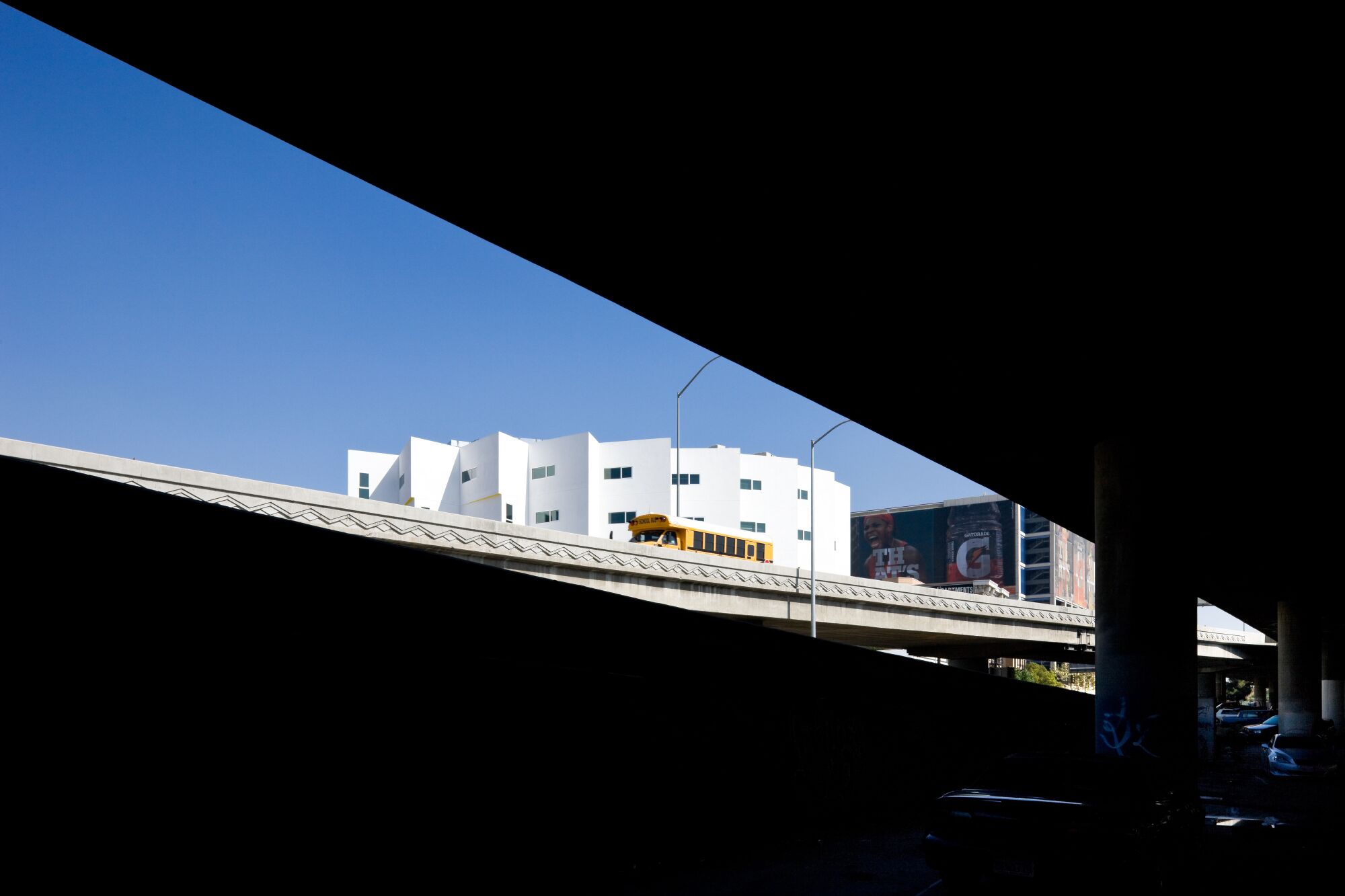
A view of the New Carver Apartments in downtown Los Angeles, managed by the Skid Row Housing Trust.
(Iwan Baan)
In theory, those loans would have been repaid with fees from several projects in development. But five projects that had received funding from the city’s $1.2-billion Proposition HHH bond were plagued by delays, and the trust handed two of them to other developers to get out from under their holding costs.
And the Edward project was drawing scrutiny from state housing officials.
An October 2020 staff report on the trust’s application for tax credits to complete the Edward project showed that it qualified for nearly $4.7 million in city and state loans. But the state Housing and Community Development Department was about to kill the project, saying it had not approved demolition of the building or relocation of its tenants.
In April 2021, state housing officials notified Raagas that they had found “compliance matters across the trust’s portfolio” and “multiple areas of organizational concern.”
These included negative cash flow at 60% of its projects with state funding, liabilities dwarfing its assets, high staff turnover and insufficient resources to complete five projects in development.
The agency found that the trust had removed tenants from the Edward, improperly used $100,000 from the Edward’s reserves for operating costs, kept units at the Simone vacant to
relocate tenants from the Edward and used more than $200,000 in Simone development funds for relocation expenses.
That June, three local housing agencies as well as the Los Angeles County departments of health services and mental health warned the trust of habitability and safety issues that were causing clients to decline housing in its buildings. They demanded a written plan to fix the problems.
By September, finding that the trust had failed to make corrections, the state housing agency declared it ineligible for further state funding — a blow that cut off its development pipeline and with it the developer fees that were a critical source of revenue.
In November, state housing officials visited more than a dozen of the trust’s properties and found 250 habitability violations.
Over similar concerns, the Los Angeles Housing Department notified the trust that 13 of its properties — those with loans from the city — were in default for failing to live up to the terms of their agreement.
The notices are the first step toward the city foreclosing to turn the properties over to different housing providers.
Ann Sewell, general manager of LAHD, suggested that the trust divest its 29 properties. She recommended a plan to make them attractive to other housing providers by combining those with positive cash flows and others that are underwater into financially viable packages.
Creditors also went to court. First National Bank of Omaha says it’s owed nearly $50,000. Abode Communities, another leader in low-cost housing, filed suit over a $186,769 bill for architectural services.
Leaders of other skid row organizations told The Times that they have unpaid bills for services to the trust but are trying to resolve them without going to court.
Internal dissent reached a breaking point last March after CBS Los Angeles aired a report on deplorable conditions at St. Mark’s Hotel.
Raagas’ attempt to dismiss the report as overblown, as well as the whistleblower complaints against her, contributed to her downfall, said three sources who were involved in the board discussions at this time and declined to be quoted by name.
“I saw the pictures in that news report of literally, the worst slum housing I’d ever experienced, visually, I was just dumbfounded,” one source said.
Several senior staff members also reacted with another whistleblower complaint ascribing blame to both the board and the chief executive.
They attributed the crisis to “overall lack of controls and financial chaos,” saying the project management office lacked financial controls and was hemorrhaging money while the trust was struggling to care for its residents and complete its developments.
“The organization is perilously close to failure if immediate changes are not made and substantial nonessential costs like the project management office are not removed,” the whistleblowers wrote.
The board fired Raagas that month. Raagas has filed a lawsuit against the trust and board member Patrick Spillane, alleging she was fired in retaliation for complaining that Spillane “cultivated a culture of hostility towards women.”
Raagas’ attorney Rushovich said the lawsuit describes the “challenges she and others faced as women at the Trust.” He did not respond to the nepotism allegations.
In a written statement, Spillane said, “We will vigorously defend against her claims in court.”
By the end of 2022, all three staff members who had told the board in March that it was still possible to fix the organization were no longer working there.
“We were wrong,” one told The Times.
Stay connected with us on social media platform for instant update click here to join our Twitter, & Facebook
We are now on Telegram. Click here to join our channel (@TechiUpdate) and stay updated with the latest Technology headlines.
For all the latest Art-Culture News Click Here
